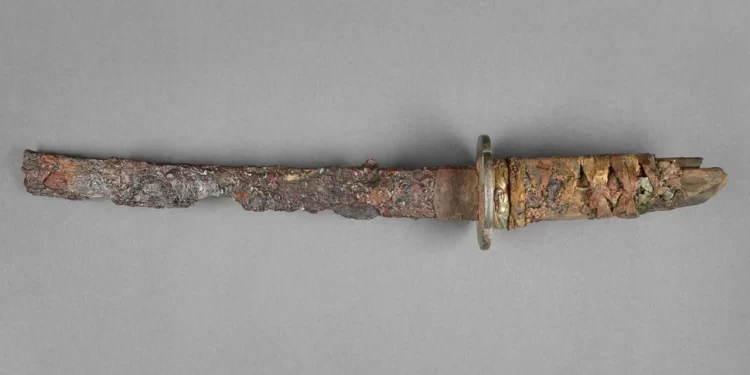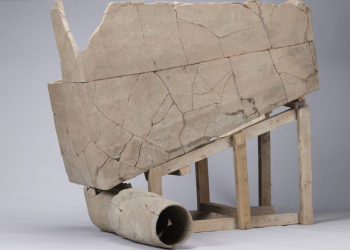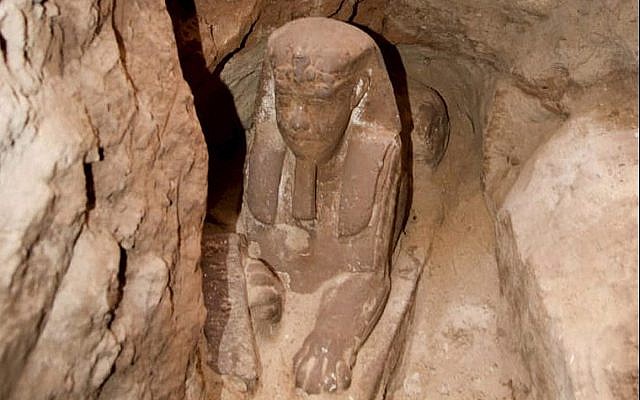A rare 17th-century Japanese samurai sword has been uncovered by archaeologists in Germany, found amidst the ruins of a cellar destroyed during World War II. The discovery took place at Molkenmarkt, the oldest square in Berlin, where the team unearthed a heavily corroded short sword, known as a wakizashi. Initially mistaken for a military parade saber, further analysis confirmed that the sword originated from Japan’s Edo period (1603 to 1868). Remarkably, experts suggest the blade might be even older, potentially dating back to the 16th century, according to a statement from the Museum of Prehistory and Early History of the Berlin State Museums. It is speculated that the sword could have been brought to Germany in the 1800s as part of a diplomatic mission.
“Who could have imagined that such a long-used and richly decorated weapon, originating from a time when Japan was largely isolated and had minimal European contact, would end up here in Berlin?” remarked Matthias Wemhoff, the State Archaeologist of Berlin and Director of the Museum of Prehistory and Early History, in the statement.
The sword was discovered in the winter of 2022 by archaeologists from the Berlin State Office for Monuments. They were excavating the remains of residential and commercial cellars in Molkenmarkt, which had been reduced to rubble during World War II and later covered with streets and intersections in the 1960s. The site was filled with war-related artifacts, including bridles, stirrups, curbs, and harnesses discarded towards the war’s end. However, the presence of a Japanese sword among these items was entirely unexpected.
Subsequent restoration revealed that the weapon was a fragmentary wakizashi, a sword historically reserved for dignitaries as a status symbol. Wakizashi swords were traditionally carried by samurai as a secondary weapon, particularly useful in confined spaces where a longer katana would be impractical. The British Museum notes that these swords were also known as “companion swords” and were always worn by men of the samurai class.
Although the sword’s wooden handle was damaged by heat, fragments of the wood and textile wrappings have been preserved. Restoration efforts also revealed a 0.4-inch-wide (1-centimeter) ferrule—a metal ring at the base of the handle—featuring an image of Daikoku, one of Japan’s seven gods of luck, identifiable by his hammer and rice sack. Additionally, the sword’s guard was decorated with now-damaged painted chrysanthemum flowers and water lines, indicative of its Edo period origins.
An X-ray examination revealed that the blade had been shortened and the handle was not original, with two holes in the tang (the hidden part of the sword that holds it together) indicating where wooden pins would have attached the original handle. The current handle, however, is attached with only one pin, suggesting that the blade might date back to the 1500s, making it older than previously thought.
The sword’s journey to Berlin remains a mystery, though Wemhoff offered some theories. He speculated that the sword might have been a gift from the Takenouchi Mission in 1862 or the Iwakura Mission eleven years later—both diplomatic missions from Japan to Europe and the Western world. The close proximity of Molkenmarkt to the Berlin Palace, surrounded by aristocratic palaces, supports this hypothesis.
German ruler Wilhelm I hosted the Japanese embassy from the Takenouchi Mission at his palace while he was king, and later, as emperor, he received the Iwakura Mission in 1873. However, how the sword ended up being discarded in the rubble of Molkenmarkt during World War II remains unknown, adding another layer of intrigue to this extraordinary find.











